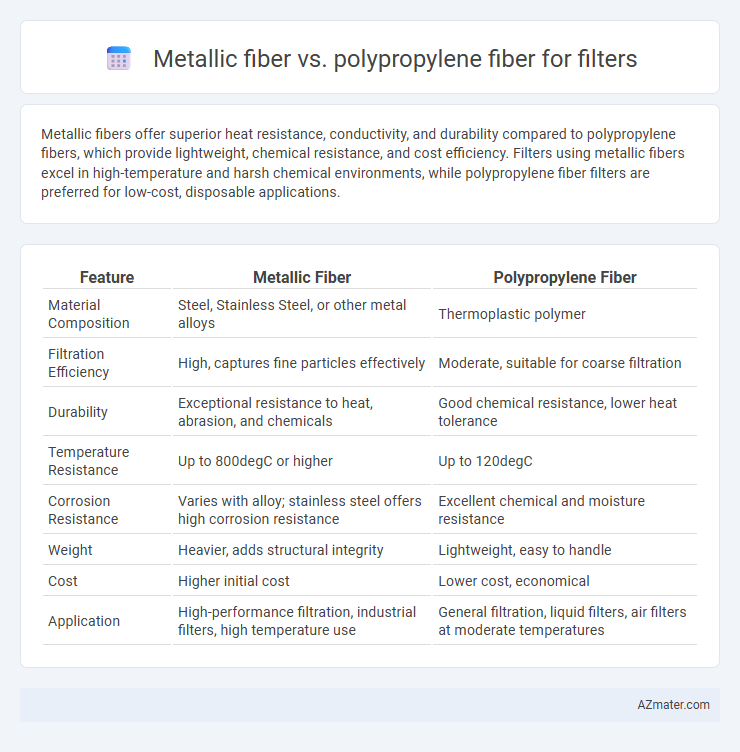Metallic fibers offer superior heat resistance, conductivity, and durability compared to polypropylene fibers, which provide lightweight, chemical resistance, and cost efficiency. Filters using metallic fibers excel in high-temperature and harsh chemical environments, while polypropylene fiber filters are preferred for low-cost, disposable applications.
Table of Comparison
| Feature | Metallic Fiber | Polypropylene Fiber |
|---|---|---|
| Material Composition | Steel, Stainless Steel, or other metal alloys | Thermoplastic polymer |
| Filtration Efficiency | High, captures fine particles effectively | Moderate, suitable for coarse filtration |
| Durability | Exceptional resistance to heat, abrasion, and chemicals | Good chemical resistance, lower heat tolerance |
| Temperature Resistance | Up to 800degC or higher | Up to 120degC |
| Corrosion Resistance | Varies with alloy; stainless steel offers high corrosion resistance | Excellent chemical and moisture resistance |
| Weight | Heavier, adds structural integrity | Lightweight, easy to handle |
| Cost | Higher initial cost | Lower cost, economical |
| Application | High-performance filtration, industrial filters, high temperature use | General filtration, liquid filters, air filters at moderate temperatures |
Introduction to Filtering Materials
Metallic fibers exhibit superior durability, thermal resistance, and conductivity, making them ideal for high-temperature and corrosive filtration environments. Polypropylene fibers offer lightweight, chemical resistance, and cost-effective solutions, commonly used in water and air filtration applications. Selecting between metallic and polypropylene fibers depends on specific filtration requirements such as temperature, chemical exposure, and desired filtration efficiency.
Overview of Metallic Fiber Filters
Metallic fiber filters utilize fine metal strands such as stainless steel or copper, providing excellent durability, high temperature resistance, and corrosion resistance essential for demanding filtration applications in industries like chemical processing and automotive exhaust systems. These filters offer superior mechanical strength and can be cleaned and reused multiple times, reducing long-term operational costs compared to disposable polypropylene fiber filters, which are made from synthetic polymer with lower temperature and chemical resistance. The enhanced conductivity and structural stability of metallic fiber filters enable efficient particle capture and consistent performance under harsh environmental conditions.
Overview of Polypropylene Fiber Filters
Polypropylene fiber filters offer excellent chemical resistance, low cost, and lightweight properties, making them ideal for various filtration applications including water treatment and industrial processes. These fibers exhibit high hydrophobicity, preventing moisture absorption and maintaining filter efficiency under wet conditions. Unlike metallic fibers, polypropylene fibers resist corrosion and are easy to fabricate into fine mesh structures, enhancing their performance in particulate removal and durability.
Filtration Efficiency: Metallic vs Polypropylene
Metallic fibers exhibit superior filtration efficiency compared to polypropylene fibers due to their inherent conductivity and ability to capture fine particles through electrostatic attraction and mechanical filtration. Polypropylene fibers, while offering good chemical resistance and low cost, generally have larger pore sizes and lower electrostatic capture, resulting in reduced filtration performance for ultra-fine particles. The enhanced durability and regeneration potential of metallic fiber filters make them ideal for high-performance filtration applications where maximum particle retention is critical.
Durability and Longevity Comparison
Metallic fibers exhibit superior durability and longevity in filters due to their high resistance to heat, corrosion, and mechanical wear compared to polypropylene fibers. Polypropylene fibers, while lightweight and cost-effective, degrade faster under harsh environmental conditions and exposure to chemicals, reducing filter lifespan. The robustness of metallic fibers makes them ideal for industrial filtration applications requiring long-term performance and repeated cleaning cycles.
Temperature and Chemical Resistance
Metallic fibers exhibit superior temperature resistance, often withstanding conditions above 1000degC, making them ideal for high-temperature filtration applications compared to polypropylene fibers, which generally resist temperatures only up to 100-130degC. Chemical resistance varies significantly; metallic fibers maintain stability against solvents, acids, and alkalis, while polypropylene fibers can degrade under strong oxidative chemicals and petroleum-based solvents. Selecting metallic fibers ensures enhanced durability and performance in harsh thermal and chemical environments, whereas polypropylene fibers are better suited for low-temperature and less aggressive chemical exposures.
Cost and Economic Considerations
Metallic fibers generally incur higher initial costs compared to polypropylene fibers due to their raw material expense and complex manufacturing processes. Polypropylene fibers offer a cost-effective alternative with lower production and material costs, making them economically favorable for large-scale filtration applications. Long-term considerations also include metallic fibers' durability and recyclability, which can offset upfront costs in specific industrial filters.
Environmental Impact and Sustainability
Metallic fibers, often made from stainless steel or other metals, offer excellent durability and recyclability, but their production involves high energy consumption and mining impacts, raising environmental concerns. Polypropylene fibers, derived from petrochemicals, have lower initial environmental footprints and are lightweight for efficient filtration but pose challenges in biodegradability and contribute to microplastic pollution. Sustainable filter solutions increasingly favor polypropylene alternatives with advancements in bio-based polymers and recycling programs to mitigate long-term ecological effects.
Typical Applications and Industry Usage
Metallic fibers are widely used in high-temperature filtration, chemical processing, and industrial gas filtration due to their exceptional heat resistance, durability, and conductivity. Polypropylene fibers dominate in liquid filtration, air purification, and dust collection applications where chemical resistance, cost-effectiveness, and lightweight properties are essential. Industries such as petrochemical, automotive, and power generation prefer metallic fibers for harsh environments, while food processing, pharmaceuticals, and HVAC systems extensively utilize polypropylene fiber filters for efficient contaminant removal.
Choosing the Right Filter: Key Considerations
Metallic fibers offer superior heat resistance, chemical stability, and durability, making them ideal for high-temperature and corrosive filtration environments. Polypropylene fibers provide excellent chemical resistance, lightweight characteristics, and cost-effectiveness, suitable for filtering non-abrasive, low-temperature fluids. Key considerations include operating temperature, chemical exposure, filtration efficiency, and budget constraints to select the most appropriate fiber type for optimal filter performance.

Infographic: Metallic fiber vs Polypropylene fiber for Filter
 azmater.com
azmater.com